Kalman Filter PowerPoint PPT Presentation
1 / 14
Title: Kalman Filter
1
Kalman Filter
2
Kalman Filter(1)
- Kalman filter is used to estimate the state of a
system by using the (noisy) measurements. - The measurements and system models are used as
inputs to a feedback filter (which is again
represented by a differential equation) - The expected error between the actual and
estimated value satisfies the Riccati equation - dS(t)/dt 2F(t)S(t) G2(t)/D2(t) S2(t)
C2(t)
3
Kalman Filter(2)
- Kalman Filter uses the Concept of Orthogonal
projection to estimate the state of a system. - The orthogonal projection of a vector on a plane
is the approximation of the vector that has the
least error
4
Kalman Filter(3)
- The Plane that we want to project the state x of
the system is a (possibly non-linear) space of
the measurements and model of the system - In this talk, we assume a linear system x(t)
s.t.- - dxt F(t)xt dt C(t)dUt
- Ut is the brownian motion.
- The measurements may be noisy as well-
- dZt/dt Ht G(t).xt.dt D(t)dVt
- Vt is the brownian motion
5
Kalman Filter(4)
Error between actual and estimated state should
be orthogonal to the measurement space
Space of Measurements and system model
System State
Estimated State
6
Kalman Filter(5)
- Question is, what is the projection (or inner
product) wrt. a space for stochastic processes? - It is the joint expectation E(xy)
- If xH is the indicator variable of a space H,
then E(z.xH) E(z H) - Question is, what is the expression of such a
conditional expectation. How do we characterize H
(its dimension, basis etc.)?
7
Kalman Filter(6)
- If (x,z1,z2,..,zn) are jointly gaussian, then-
- The best estimator of x derived from
z1,z2,..,zn E(x z1,z2,..,zn) is the same as
some linear combination PL (z1,z2,..,zn) of
z1,z2,..,zn. - For any other distribution, a linear combination
is worst estimator than E(x z1,z2,..,zn) - If we can prove that the state and measurements
are jointly gaussian, then we need to calculate
the best linear estimator only.
8
Kalman Filter(7)
- For a linear system, the pair (xt,zt) is jointly
gaussian ( Picards Iteration method). - Hence, a linear combination of Zt is sufficient
to get the best estimate for Xt. - Since, Zt is continuous with time, we will take a
linear functional of Zt - The best estimate xest(t) is given as -
- xest(t) E(xt) ? f(t)dzt.
- ? f(t,xt)dzt represents the same space as finite
linear combinations of Zt. - Now, we need to find f(t,xt).
9
Kalman Filter(8)
- We look at the differential equation of the
measurements- - dZt/dt Ht G(t).xt.dt D(t)dVt
- Then dRt G(t). (xt - xest)dt
D(t)dVt /D(t) dzt G(t)xest /D(t) is a
brownian motion wrt. the measurement space. - It is possible as D(t) is assumed to be bounded
away from zero. - xt xest is orthogonal to the measurement space.
- Since, xest is in linear space of zt, dRt also
spans the linear space of zt
10
Kalman Filter(9)
- Now we can state the following-
- xest(t) E(xt) ?s(t)dRt
- We now need to find s(t,xt)
- Note that xt xest(t) is orthogonal to any
?f(t)dRt - Hence, E(xt xest(t). ?f(t)dRt) 0
- This gives us-
- E(xt. ?f(t)dRt) E(xt).E(?f(t)dRt) E(?s(t)dRt.
?f(t)dRt) - E(xt. ?f(t)dRt) 0 E(?s(t)dRt. ?f(t)dRt)
- Select f(t) I(t lt y) (indicator function) to
get- - E(xt. Ry) E(?s(t)dRt. Ry) E(?s(t)dt)
?s(t)dt, from 0 to y - ?/dy( E(xt. Ry) ) s(y)
11
Kalman Filter(10)
- So we get-
- xest(t) E(xt) ?s(y)dRy
- dRt G(t). (xt - xest)dt D(t)dVt /D(t)
dzt G(t)xest /D(t) (from the model of
measurements) - The system equation is solved to get expression
for xt - s(y) ?/dy E(xt.Ry)
- It can be proved that the expected error xerr(t)
satisfies the riccati equation- - ?xerr/dt 2F(t)xerr(t) - G2(t)/D2(t)
xerr(t)2 C2(t)
12
Kalman Filter(10)
- Solving explicitly for xt for a linear system, we
get the following equation for xest- - ?xest/dt F(t) D-2(t).G2(t).xerr xest.dt
D-2(t).G(t).xerr dZt - ?xerr/dt 2F(t)xerr(t) - G2(t)/D2(t)
xerr(t)2 C2(t) (Riccati equation) - dxt F(t)xt dt C(t)dUtMM
- xt e?F(y)dy x0 ? e-?F(y)dy .C(y).dUy
13
Kalman Filter(11) Example for a brownian motion
Actual State
Estimated State
14
Kalman Filter(12) Example for a brownian
motion(2)
Actual Squared Error in this case
Expected Theoretical Error

